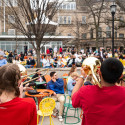Students move in to residence halls this weekend
About 7,000 students will move into university residence halls beginning this Friday and Saturday, Aug. 27-28.
Teams of faculty, staff and “Badger Buddies” — returning student residents who can answer questions — will greet new students during move-in day. Residence halls open at 7 a.m.
|
See also: Traffic tips for move-in days |
The Division of University Housing takes great care to spread out the moving process to avoid logjams, but Madison commuters traveling on or near campus Friday may want to rearrange their routes to avoid streets near the southeast residence halls along West Johnson Street and the west campus near the lakeshore residence halls.
Among other changes this fall, students in the residence halls will enjoy a smoke-free atmosphere. Smoking now will be banned in all residence halls, including student rooms, says Paul Evans, director of University Housing.
Smoking previously was prohibited in public areas of university housing, such as dens, lounges and corridors. More than half of campus residence halls had been smoke-free in the past.
The university has enforced a smoke-free policy for other campus buildings since 1991 as a way to promote campus health. The original policy applied to most UW–Madison buildings, including individual offices.
And as usual, some students will be placed in temporary housing, but they will live as well as students with permanent room assignments, housing officials say.
About 200 students have been assigned to short-course residence halls and residence hall dens because of this fall’s larger-than-expected group of incoming first-year students, says Alice Gustafson, assistant director of University Housing.
The university each year typically accepts more students than it can house because a percentage of students cancel housing at the last minute or leave the university during the first weeks of classes.
“We try to maximize the number of students who will have an opportunity to live in our residence halls, and that sometimes requires us to place students in temporary housing,” Evans says. “This process helps minimize overall vacancy rates and keeps student housing rates as low as possible.”
This year’s group is larger than the usual 90 or so students who are initially assigned to temporary quarters. But all contracts with student residents will be honored and all students in temporary housing eventually will receive room assignments, many of them in the residence halls they initially requested in their applications.
Students in short-course residence halls, the Humphrey and Jorns halls near the Lake Mendota shore, will occupy quarters that are essentially the same as residence hall rooms.
And students placed in residence hall dens, large areas that are normally open to all residents on a floor, will be provided with furnishings including beds and desks, telephones, refrigerators, data ports for their computers, cable TV and wardrobe space, among other things.
Each temporary resident will be assigned to a housefellow who can help the student get oriented to campus, the residents in temporary housing have the same access to food service, academic resources and cultural facilities, Gustafson says.
Even so, these residents will get a 20 percent discount on fall semester housing fees for the period they remain in temporary housing, Gustafson says.
The temporary assignments come as no surprise to arriving students. Housing officials notified the students last spring that they did not have a permanent room assignment, explaining the situation and how it will be resolved.
Gustafson says she’s impressed by the group’s willingness to roll with the changes. “Our students have been patient and respectful, and their parents have been incredibly gracious,” Gustafson says.



